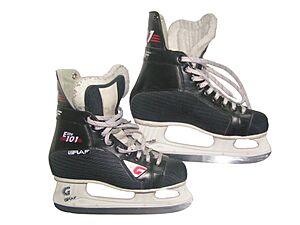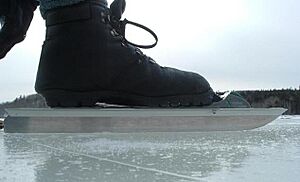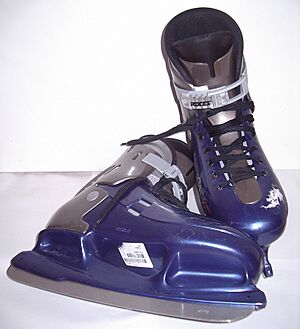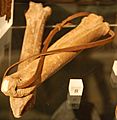Ice skate facts for kids
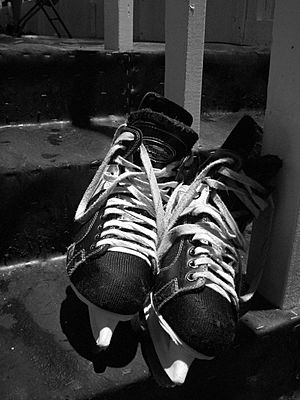
Ice skates are special boots with metal blades on the bottom. People wear them to glide across ice when they go ice skating.
Long ago, the very first ice skates were quite different. They were made from the leg bones of animals like horses, oxen, or deer. People would tie these bones to their feet with leather straps. To move forward, skaters had to push themselves with a pole that had a sharp metal spike. This is very different from how modern skates work!
Today, there are many kinds of ice skates, each designed for different activities. You can wear them for fun at ice rinks or on frozen lakes and ponds around the world. Skates are also important equipment for many sports, including figure skating, ice hockey, bandy, speed skating, and tour skating.
Contents
Different Kinds of Ice Skates
There are four main types of ice skates, each made for a specific purpose.
Figure Skates
Figure skates are used in the beautiful sport of figure skating. These skates have a special part called a toe pick at the front of the blade. Toe picks are usually made from strong aluminum or steel.
Skaters use the toe pick for many things, especially for certain jumps like the axel and toe loop. The boots for figure skates are usually made from several layers of leather. This leather is very stiff to give lots of support to the skater's ankles.
Hockey Skates
Hockey skates are designed for playing fast-paced games like ice hockey and ringette. The boot of a hockey skate is often made from molded plastic, strong synthetic leather, and tough ballistic nylon.
For competitive hockey, skates rarely use molded plastic for the upper part of the boot. This is because plastic can limit how much a player can move. All hockey skates, except for those worn by goalies, are made to be safe and not cause injury to other players. They also have special safety blades.
Speed Skates
Racing skates, also known as speed skates, have very long blades. These skates are used for speed skating races. A special type of speed skate is called a clap skate. With a clap skate, the shoe is connected to the blade with a hinge. This hinge allows the blade to stay on the ice longer during each stride, helping skaters go faster.
Touring Skates
Touring skates, also called Nordic skates, have long blades. These blades can be attached to hiking or cross-country ski boots using special bindings. People use them for tour skating or long-distance skating on natural ice, like frozen lakes.
The blades are about 50 centimeters (20 inches) long and are very thin, about 1 millimeter wide. Their length helps touring skates feel more stable on bumpy natural ice compared to skates with shorter blades. Since tour skating often involves walking between different ice patches, it's helpful that the blades can be easily removed from the boots. While mostly used for fun trips, touring skates are sometimes used in marathon speed skating races on natural ice.
Skates for Fun
Skates that are made for casual skating, often called recreational skates, usually look like either figure skates or hockey skates. You can also find recreational skates that look a bit like inline skates, with a molded plastic boot.
These recreational skates are the kind you can often rent at ice rinks if you don't own your own skates. Some experienced skaters jokingly call them 'death wellies' because of how they look and their reputation for causing blisters!
The Invention of Steel Skates
The modern steel ice skate was invented in 1867. It was created by John Forbes, who was a foreman at the Starr Manufacturing Company in Dartmouth, Nova Scotia, Canada. His design was a "clip-on" skate, meaning it could be attached to regular boots. Their brand, Acme, became famous all over the world.
Images for kids
-
Ice skating in Graz in 1909
-
Medieval bone skates on display at the Museum of London
-
Charles Goodman Tebbutt doing a speed skating pose in 1889. He published the first set of rules for bandy



